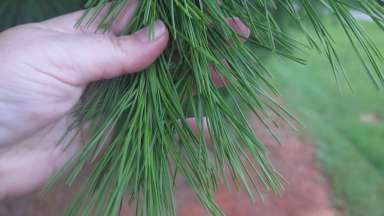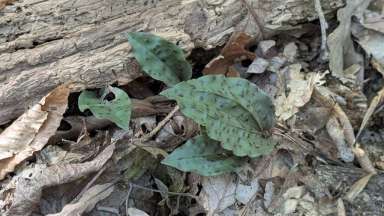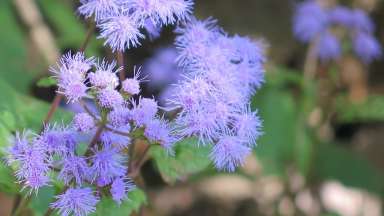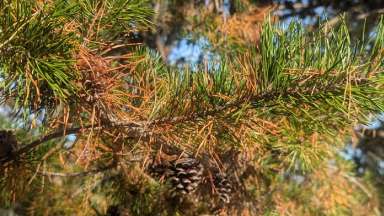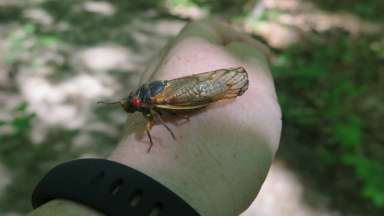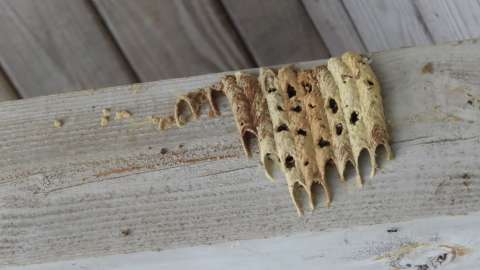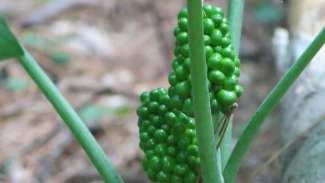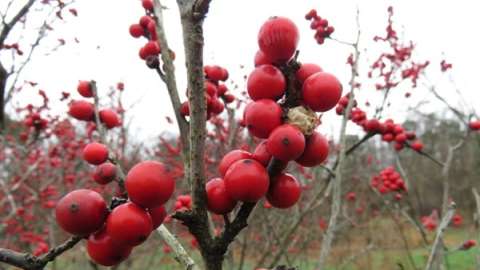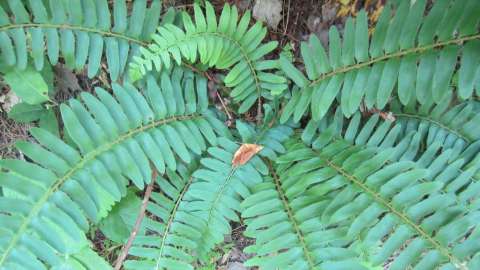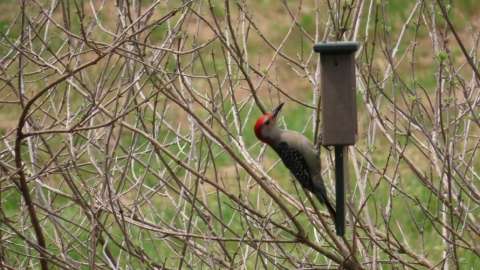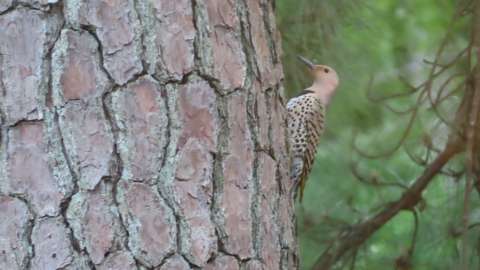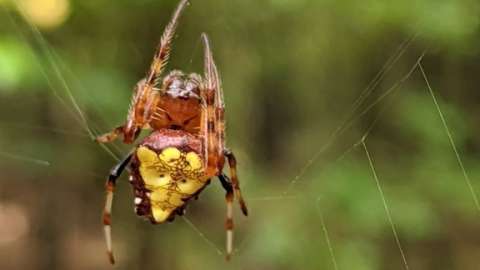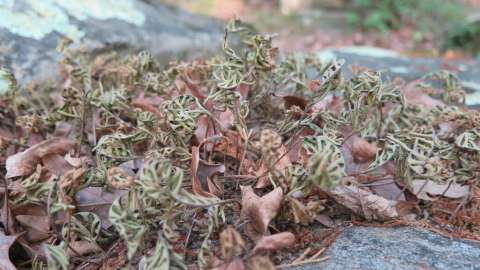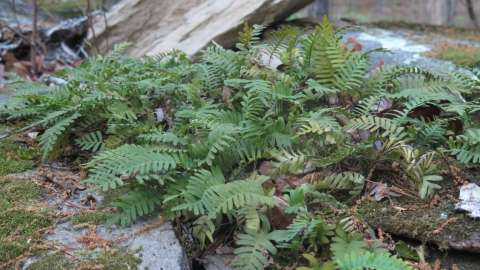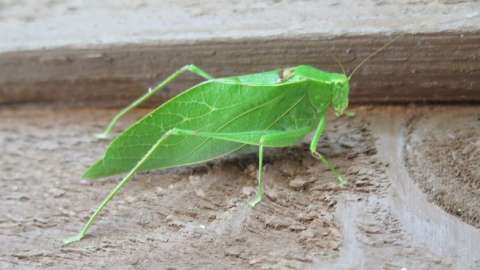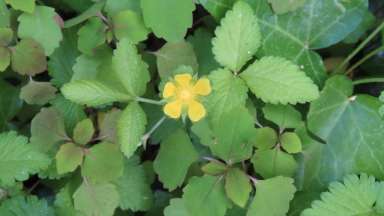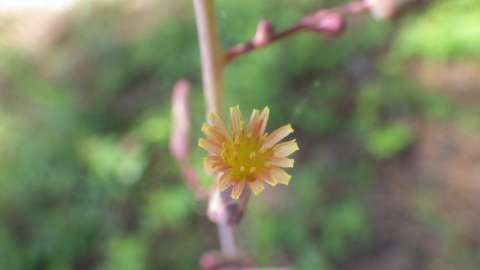Jump To:
Less common, but still fairly abundant as a wild tree around Raleigh, is the Shortleaf Pine (Pinus echinata). Shortleaf Pine needles are 2-5 inches long and occur as 2 needles per bundle. Their cones are smaller (1.5-2.5 inches) are somewhat egg shaped, with very small prickles that may be hard to see. Shortleaf Pine wood makes good timber, but they grow more slowly than Loblolly Pine.
Even less common but still sparsely present in the wild is the Virginia Pine (Pinus virginiana). Virginia pine has even shorter needles than the Shortleaf Pine - just 1.5-3 inches long! Like the Shortleaf Pine, Virginia Pine needles occur as 2 per bundle, but its short needles are thicker and have a slight twist in them. Virginia Pine’s cones small, about the same size as Shortleaf Pine cones, but have longer, sharper prickles that are easy to see and feel – ouch!
Other pines can also be found around Raleigh, especially planted in yards, but these three are the most common to find in the wild. They all add an evergreen touch to a winter walk. Look for them all near you this winter!
On the forest floor, you may see a single green leaf that is sometimes shiny with purple spots. When you flip the leaf over, the underside is purple. While they sometimes grow in clusters, each leaf is an individual plant. The leaf remains visible throughout the winter and disappears in the spring. While it only has one leaf above ground, underground, the plant stores energy in a bulb-like structure and has a symbiotic relationship with the forest fungi to absorb additional nutrients.
In the spring, after the leaves have disappeared, the crane-fly orchid sends up a tall spike of irregularly shaped blooms. The blooms resemble the long, thin bodies and wings of craneflies, and bloom from July to September. These blooms are visited by noctuid moths (such as the armyworm moth), and the pollen sticks to their eyes before they transfer the pollen to the next flower. After September, the flower dies back, and the new leaves emerge again in October.
Next time you go for a walk in the woods, see if you can find the crane-fly orchid leaves hiding under the autumn fallen leaves! And, if you can remember, see if you can spy their flowers next summer!
Throughout the summer Mistflower is inconspicuous with wrinkly green leaves growing opposite (across from each other) on a stem from 1 to 3 feet tall. Mistflower grows well in full sun to partial shade, but not in deep shade. It prefers moist, rich soils and tends to inhabit sunny, moist habitats such as meadows, floodplains, stream banks, and roadside ditches.
Mistflower is in the Aster family of plants, related to daisies and sunflowers. Like other members of the Aster family, each Mistflower flower-head is made up of many very tiny individual flowers packed closely together. These tiny individual flowers bear the thin purplish petals that give the flower heads a “fuzzy” appearance overall.
As a late-season bloomer, Mistflower produces a nectar-rich source of food for butterflies, bees, and other beneficial insects in the fall season. After the petals fall and the flowers turn into seeds, birds can enjoy eating the small seeds in late fall and into the winter. But deer also love to eat Mistflower’s leaves and stems during the summer months, which can prevent flowers from forming in fall if the stems have been too heavily browsed.
Have you seen Mistflowers during your fall walks around Raleigh? Look closer for fall pollinators are enjoying their blue-purple blossoms!
Dragonfly vs. Damselfly – What’s the difference?
It’s that time of year when dragonflies are zipping around most of our ponds and lakes, and sometimes even around in the woods! But did you know there’s also another group of dragonfly-like insects called damselflies? You’ve likely seen them, and perhaps considered them smaller dragonflies. So, what is the difference?
Both dragonflies and damselflies are insects in the order Odonata, but then they are split into two suborders: Anisoptera (Dragonflies) and Zygoptera (Damselflies). One of the main differences that split them into these suborders is their wing shape. Both have two pairs of wings: a pair of forewings (towards the head) and a pair of hind wings (towards the tail).
Anisoptera means “different wing” and refers the fact that the outline of the dragonfly’s forewings and hindwings are slightly different. This can be seen when a dragonfly lands because they usually rest with their four wings spread out away from their sides. When flying, dragonflies can use these specialized wings to zoom around at high speeds or to hover in one place. Additionally, dragonflies are considered to be bigger-bodied.
Zygoptera means “same wing”. Damselflies have fore and hind wings that are all the same shape and size, so they can fold all four wings together perfectly above their body when they land. When flying, damselflies often seem to skip and dance through the air in a bouncy manner, instead of flying directly like a dragonfly.
Damselflies also tend to be very slender in body shape compared to dragonflies.
Both dragonflies and damselflies depend on water sources for reproduction. They lay their eggs in the water and the larvae begin life as a predacious aquatic insect, eating small insects such as mosquito larvae. During metamorphosis, the larvae crawl out of the water and molt their exoskeleton and emerge with wings for their adult life on land. Both dragonflies and damselflies are predators as adults, continuing to hunt smaller insects such as mosquitoes and other flies.
Overall, dragonflies and damselflies are great species to have around! Next time you see one, look closely -- is it a dragon or a damsel?
Why is Everything Covered in Yellow?
Ahh, spring. Leaves are emerging from the trees, flowers are beginning to sprout from the ground, and the whole city is covered in yellow dust. This yellow substance covers our cars, gathers on the surfaces of puddles, and some days clouds of yellow can be seen crossing the sky. You may be aware that this yellow dest is pollen, but do you know which plant most of it is coming from?
When you think of pollen, flowers likely come to mind. However, some trees, like pine trees, are not flowering plants. Instead, they reproduce using cones. Flowers are used to attract pollinators, often by offering nectar as a food source. Many flowers also have colorful petals to get the attention of a variety of pollinators. But there are no petals on a pine cone that would attract a pollinator, and no nectar. Instead of attracting pollinators to move pollen from tree to tree, pine trees rely on wind dispersal.
To reproduce, pines have two types of cones. We can call them male cones and female cones. The male cone is smaller and produces the pollen. During pollen season they are soft sided and yellow-orange colored, and when touched pollen grains will easily fall off onto your hands. When their pollen is fully expelled, they turn brown and shrivel, and fall to the ground in large numbers. Separately, the female cone becomes what most people imagine when you hear “pine cone”. In spring it is tiny, and easy to overlook. This young female cone captures pollen from the air as it falls. The pollen makes its way inside the female cone and after several months the cone grows into a large, prickly “pine cone” with many seeds inside. If you ever see a pine cone that has been torn apart by squirrels, it is because they’re after these seeds.
While this thick yellow pollen can be a visual nuisance, it may put your mind at ease that people with spring allergies are not usually reacting allergically to pines because the grains are too large to be absorbed by humans. However, there are many other wind-pollinated plants which are producing pollen at the same time with smaller grains that we cannot as easily see, including oak trees and grasses, which may trigger spring allergies.
What you’re seeing is called lichen (pronounced “liken”). It is alive, although it grows very slowly. It makes its food from sunlight and gets the water it needs from rain and dew, but it is not a plant.
Lichen is a lifeform that is a partnership between a fungus and an algae, where tiny algae live inside a larger fungus body. Having these tiny algae inside allows lichen-fungi to live in places where other fungi could not find food to live – such as on a bare rock.
The fungus provides structure and protection for the algae, and the tiny algae inside the fungus can create food from sunlight by photosynthesis – something a fungi could not do by itself. While algae usually require a wet environment, the protection that the fungus body provides allows these symbiotic algae to survive even on places that can become very hot and dry.
Lichens are eaten as food by many animals (ranging from tiny slugs to deer) and lichen is also gathered by wildlife such as birds for nest-building material.
Lichens naturally absorb many things from the atmosphere around them, and they are studied by scientists interested in pollution levels present in the atmosphere. In areas with heavy air pollution, few lichens may be able to grow at all.
Unlike plants, lichen do not have roots, stems, or leaves, but their bodies do come in many different shapes. There are over 20,000 species of lichen which can be grouped into three main shape types:
- Foliose lichens, appear flattened but with leafy ruffles.
- Fruticose lichens, appear highly branched or hairy and may droop downward or grow upright.
- Crustose lichens, appear as a very flat crusty patch, almost like patches of crusty paint.
Next time you see a lichen, take a good look. Can you tell which shape group it might be in?
“Wintergreen” might be a little misleading as a name, as this plant is a true evergreen (with green leaves all year-round – not just green in winter). This plant has many other common names including Spotted Wintergreen, Pipsissewa, Striped Prince’s Pine, Ratsbane, and Rheumatism Root. Its scientific name, Chimaphila, means “lover of winter”.
Usually Striped Wintergreen grows only a few inches tall, just peeking above fallen leaves on the forest floor. Each plant has a few dark green leathery leaves that resemble Holly leaves, but with an obvious whitish stripe running down around the leaf’s middle vein.
In early summer, Striped Wintergreen produces white five-petalled flowers, which are visited by insects, especially bees. Pollinated flowers develop into small greenish-white fruits which ripen to brown in the late summer. Wintergreen prefers to grow in light or medium shade, dry-soil forest areas, often under tall pine trees. Despite its small size, it grows very slowly, and it will take years to form a patch of Striped Wintergreen plants.
Next time you take a winter forest stroll, see if you notice any small evergreen plants with white-striped leaves hiding on the forest floor. You may find more Wintergreen than you expect!
One common bird adaptation is to put on some extra weight before winter. This extra weight is both insulating and can be converted into body heat. Anyone who maintains a bird feeder may observe small flocks of songbirds congregating around it as cold weather approaches. Many birds adjust their feeding strategies to seek whatever winter food is available to maintain weight. For example, American Robins that usually find worms and insects in the soil will look for food in trees and bushes when the ground is frozen solid.
Feathers are also vital in helping to keep birds warm. Feathers provide a barrier between birds’ bodies and the elements, and birds will also fluff up their feathers to trap more air around their bodies to increase insulation. For body parts that lack feathers, such as a bird’s feet, the blood circulation pattern in their legs and feet also works to reduce heat loss.
When outside temperatures become very harsh, birds will seek shelter in wind-protected places such as bushes and tree crevices, sometimes huddling together for additional warmth. Birds can also reduce their body temperature at night to save energy and reduce their rate of heat loss. Some small birds, such as chickadees, can even allow their internal body temperature to drop from a normally very warm 105*F to only 85*F (which would cause fatal hypothermia in a human body) allowing them to use less energy during cold nights. Their body temperature warms back up quickly in the morning when they resume normal activity.
With this combination of physical and behavioral adaptations to the winter, our birds can be incredibly resilient, even when the temperatures dip below freezing.
Do “Evergreen” Pine Trees Ever Lose Their Needles?
During the fall we all know that many of our trees lose their leaves. Most of our trees are deciduous and have leaves that change color in the fall and eventually drop by winter, leaving their branches bare until spring. However, “evergreen” trees like pines appear to stay green all year. Of course, anyone who hikes any trail in our area will find abundant pine needles fallen to the ground, so we know they must fall at some point. But do they ever shed most of their needles at once?
Though pines and most other conifers are called evergreens, their needles do not stay alive forever. Generally, new needles are produced annually during the spring and summer. While needles can fall year-round, their biggest shed is after the growing season.
As needles age, they become less efficient at helping with the process of photosynthesis. They also become shaded by growing branches and newer needles. During the fall the older needles start turning brown and drop from the tree in larger quantities than normal, allowing the newer green needles more space and access to the sun.
Some may see a pine tree turning brown and be concerned. If the browning needles are towards the branch tips you may have reason for concern of disease or insect damage. If the whole tree is turning brown that could be a symptom of drought. However, if the browning needles are primarily on the inner parts of your tree and the outer branch tips are still green, then this is the normal cycle of needles on a healthy pine.
Ghost pipes are white because they lack chlorophyll, the green pigment other plants use to absorb the sun’s energy for photosynthesis. But ghost pipes are still true plants with flowers, pollen, and seeds like other flowering plants.
Raleigh’s ghost pipes belong to the species Monotropa uniflora which translates to “one turn” (Greek, referring to the sharp curve of the stem just before the flower) and “one flowered” (Latin). They are now usually placed in their own plant family, the Monotropaceae, or Ghost Pipe Family, with a few other similar species that also lack chlorophyll.
The number of Ghost Pipe species in North Carolina is under study. Coastal Ghost Pipes with yellow-orange stems are now considered their own species (Monotropa brittonii) and in the Piedmont and Mountains plants with deep pink stems have sometimes been named as a “Rose” form (Monotropa uniflora f. rosea)
But if Ghost Pipes do not have chlorophyll or perform photosynthesis, how do they produce energy? It turns out, that ghost pipes are parasitic! Ghost pipes parasitize on mycorrhizal fungi that live in forest soil and have a symbiotic relationship with trees. This means the mycorrhizal fungi and the tree benefit from each other. The tree performs photosynthesis, gathering energy from sunlight. The mycorrhizal fungi help absorb minerals in the soil and then exchange these minerals through the tree roots while absorbing some of the tree’s stored energy from photosynthesis.
Ghost pipes fit in by tapping into a mycorrhizal relationship with the soil fungi, although the ghost pipe only takes and gives nothing back to the fungus. It doesn’t have to perform photosynthesis, and it doesn’t have to gather minerals to exchange. It just absorbs the energy created by the tree and transfers it through the fungus. Fortunately, forest trees are very large compared to the small ghost pipes. There is no evidence of ghost pipes harming the trees, and the ghost pipes’ fall flowers do provide edible pollen and nectar to bees at a time of year when no forest trees are blooming, helping these pollinators, who in turn also pollinate many other plants during the rest of the year.
Ghost pipes spend months to even years below ground absorbing energy before they develop above ground with their white stalks and a single flower. The flower is pollinated by insects. The seeds are so small they hardly have enough food storage inside to start a new plant like most seeds would. Once dispersed by wind, the seeds do not grow right away. Instead, they mimic a tree’s root system and wait for the mycorrhizal fungus to come along, and the cycle starts over again.
In late spring to early summer persimmon trees produce many small cream-colored flowers. Persimmon trees are dioecious, meaning some trees have only male flowers and some have only female flowers. Male persimmon trees never produce fruits, only pollen. The flowers on female trees must be fertilized by pollen from a male tree’s flowers to produce fruit. These flowers are pollinated primarily by insects and are especially visited by bees.
By fall the pollinated flowers on female American Persimmon trees will become fruits – specifically, large orange berries about the size of a large cherry or a small plum. Asian Persimmons produce even larger orange fruits closer to the size of an apple. Persimmon fruits are edible and have been enjoyed by people for many generations. However, eating unripe persimmons causes an unpleasant astringent mouth-numbing effect. Unripe persimmons are firm to the touch and are greenish or yellow-orangish to medium-orange in color.
Ripe American Persimmons are deep-orange or purplish in color outside with very soft orange flesh inside, and a juicy-sticky texture and very sweet flavor. These ripe fruits will be extremely soft to the touch – this softness is a major reason why American Persimmons are rarely shipped and sold in stores. Eating a fully-ripe American Persimmon can feel almost like eating orange marmalade, except with seeds. Each globular persimmon berry contains between one and eight hard oval-shaped seeds, making eating persimmons something like eating a watermelon with seeds.
Persimmon fruit is a very important wildlife food source, eaten greedily by many animals, even including typically carnivorous species like coyotes and foxes. It is quite common in the fall to find coyote, opossum, raccoon, and fox scats full of bean-sized shiny-brown persimmon seeds. A sure sign that the fruits of the season are ripening!
Annual cicadas emerge in Raleigh every summer, and also spend many years underground before they transform into adults. But there are so many annual cicadas that you can see many of them emerging every year.
Periodical cicadas tend to emerge together in batches – or “broods” – so that some years have many more periodical cicadas emerging than other years.
The current periodical cicada emergence is comprised of multiple species in the genus Magicicada. These periodical cicadas have been underground for 13 years, while there are other species emerging in other parts of the country that have been underground for as many as 17 years. During those 13 years underground the cicadas are in their nymph stage, sucking on nutrients from tree roots. After 13 years, when the ground reaches about 64 degrees they begin to emerge. Typically emerging at night, they crawl up a vertical surface and proceed to break free of their exoskeleton, revealing a new set of wings. After fully emerged, they leave their empty exoskeletons behind and then try to fly, although they aren’t great at it. Eventually, they get themselves even higher in the trees, where the males start singing their high droning song to attract females. Once mated, the females make a small slice into tree twigs to lay eggs in. This process will only last a few weeks and then we will not see them again. After about 6 weeks the new nymphs hatch, drop the ground, and dig under where they’ll stay for another 13 years.
Raleigh is on the farthest eastern edge of their appearance. Neighborhoods in west Raleigh, Cary, Durham and towards Chatham County have the best chance of seeing the periodical cicadas, however, they’ve also been spotted in areas on the northeast edges of Falls Lake. Some neighborhoods in Raleigh and eastern Wake County may not see these periodical cicadas at all – so look out for them this year to see where they appear!
While the periodical cicadas may be loud and very abundant, they don’t otherwise pose a threat. In this adult form, their only goal is to mate and lay eggs. Therefore, the adults do not have mouth parts and cannot bite. This cicada emergence provides food for many eager wildlife species. Birds and squirrels are among species happily eating these cicadas. Luckily, there will be plenty of cicadas that complete their mating cycles and we’ll surely see them in masses again in 2037.
The name Green Anole would suggest they are always green – however, the brown-colored anole lizards seen in North Carolina are also Green Anoles too! This is because the Green Anole can change colors. Some people call our anoles “Chameleons” or “Carolina Chameleons” because of their color-changing ability, but they are not closely related to the Chameleons of Africa and Asia.
Green Anoles change color from brown to green for many reasons, including to show their mood and level of activity. Typically, if an anole is cold or less active, they will appear brown. If they are warmer and more active, they will appear green. In both colors, some anoles may also have a faint white stripe down their back.
In addition to changing colors, adult male anoles have a bright pink fan of skin under their throat, called a dewlap. This dewlap can be flared out and displayed for communication with other anoles. Sometimes this display is coupled with head bobbing and small push-ups. Females may also have a smaller, less colorful dewlap.
Anoles are excellent climbers thanks to their claws and adhesive toe pads. They are often seen climbing up walls or on fences. An anole’s diet consists primarily of small insects and spiders, making them a great species to share your backyard garden with. But with their color-changing ability, you may have to look close to see an anole, even when they are right beside you.
Yellow-bellied sapsuckers are a small member of the woodpecker family. They have mostly black and white bodies with black and white stripes on the head. They have bold red feathers starting from the top of the beak and reaching towards the back of the head. Males additionally have red throats. The yellow on their chest and bellies is often faint.
The yellow-bellied sapsuckers drill neat rows of shallow holes into tree bark. This allows them to eat the sugary sap as well as any insects that get caught in it. Rarely they may visit birdfeeders to enjoy suet. While in most cases these small holes do not cause permanent harm to the tree, it is possible that if a tree has too many holes it can affect the tree’s flow of sap to the roots, essentially girdling and killing the tree. Yellow-bellied sapsuckers prefer tree species with high sugar concentrations in their sap such as birch, maple, and hickory.
While all of the other woodpeckers in our area are year-round residents, the yellow-bellied sapsucker spends the warmer breeding months in Canada and a handful of northern states that border Canada. In the winter they travel to most of the southern states as well as Mexico, Central America, and the Caribbean. During their stay they continue to drill their small holes in search of food, leaving them behind as a reminder that they were here as they travel north again for the summer.
In addition to oak acorns, other tree nuts including hickory nuts, walnuts, beech nuts and pine nuts all contribute food for squirrels. Squirrels can round out their diets with smaller plant seeds, fruits, mushrooms, tree buds, flowers, and the occasional insect or bird egg, but tree nuts are the main item in a squirrel’s diet.
But squirrels are not only eaters of tree nuts – they also plant nuts. Every fall a squirrel can individually bury several thousand tree nuts in the ground. Some of these nuts will be dug up later to eat when food is scarce, but many will be left in the ground to germinate into tree seedlings. Chances are, many of the mighty oaks you see in forests around you were once buried as acorns by squirrels. Because squirrels usually carry acorns some distance before burying them, they help the large, heavy seeds of oaks and hickories spread farther into new places, preventing the seeds from staying only close underneath the parent tree.
When you enjoy Raleigh as a City of Oaks, those oak-filled forests are a result of many generations of seed-carrying squirrels spreading tree seeds. Those little tree-planters are now assisted by oak-tree-planting humans who can return the favor by supporting tree-rich habitats for our urban squirrels, and simultaneously helping the many birds, caterpillars, and other wild creatures who benefit greatly from the same oak trees that squirrels love.
Happy Squirrel Appreciation Day, from North Carolina and the City of Oaks!
The most common marcescent tree in Raleigh is the American Beech (Fagus grandifolia). Beech tree leaves turn yellow in autumn, along with the rest of the forest, but then often keep holding on into winter even as they fade to a light brown color.
Besides their marcescent leaves, an American Beech is easy to recognize from its very smooth and pale gray bark. This smooth gray bark is consistent on both young and old American Beech trees, which can slowly grow to very large sizes.
Younger American Beech trees are more likely to show marcescent leaves than are large, older trees, and many trees may be marcescent on their lower branches while dropping their brown leaves on their upper branches.
Besides the American Beech, some oak species (like the Shumard Oak) also keep marcescent leaves, as do some maples – particularly the Southern Sugar Maple and Chalk Maple. But the majority of oaks and maples will drop their brown leaves by the beginning of winter.
Scientists don’t know the reason why some trees show marcescence – but we do know it is genetic in many tree species and in these trees it is not a sign of any disease or ill health. However, the holding-on of dead, brown leaves in tree species not known to show marcescence can be a sign of tree injury or illness.
For trees that normally do show marcescence, it may be that the hanging dead leaves provide protection or camouflage to the living leaf buds on the tree’s branches. These buds contain nutritious tissues inside, which hungry plant-eaters in winter may attack when other foods are scarce. The dead brown leaves are not edible to most plant-eaters and may make these edible winter buds harder to find. American Beech trees have especially large, pointed, leaf buds on their twigs during winter, and these buds on their highly-marcescent lower branches are also the most vulnerable to browsers.
Whatever the benefits of marcescence to the tree, it is a characteristic of American Beech that makes it easily recognizable in winter and adds variety to our winter forest’s appearance. Look for them during your next hike in the woods!
White-throated Sparrows spend the warmer summer breeding season primarily in Canada. After breeding they typically arrive in North Carolina by mid-October and stay through late April. Their loud, confident song that sounds like “Oh-sweet-Canada-Canada-Canada” is often one of the first signs that they have arrived in late fall. At first glance the birds look like many other sparrows – but if you look closely, you’ll notice some special differences.
About half of all White-throated Sparrows have a bright white stripe (sometimes with yellow) sandwiched between dark black stripes that starts at the back of their beak, runs over their eye and across their head, and finally down to the base of the back of their neck.
However, the other half of White-throated Sparrows have a light tan stripe (sometimes with yellow) sandwiched between two dull black-brown stripes.
These two color-patterns are not males and females. They are not old and young birds either. It is simply that some White-throated Sparrows have different color patterns than others, which they are born with, even though both color patterns can breed with each other and they are all a single species.
Scientists call the two head-stripe patterns the “white morph” and “tan morph” – but they are all White-throated Sparrows.
Interestingly, researchers have discovered that there are behavioral differences between the color morphs. In their northern summertime breeding territories the white-striped males tend to use sunny open areas while the tan-striped males prefer denser, shadier forests. Also, white-striped males and females tend to sing higher notes than tan-striped makes and females, with tan-striped birds’ songs usually lower-pitched.
During the winter we see both morphs frequently in Raleigh, especially around brushy fields and visiting seed feeders. Next time you hear a bird call “Oh-sweet-Canada-Canada-Canada”, look for a winter sparrow, and see what White-Throated Sparrow morph you can find!
If you’ve seen this before, then you have discovered the Beech Blight Aphid (Grylloprociphilus imbricator). If you look closely enough, you can see that the mass of white fuzzies are many individual insects clinging to the branch. The beech blight aphid produces waxy fibers from its abdomen which gives it the fuzzy appearance. This waxy fuzz deters predators, such as beetles and wasps, from eating them. In fact, when disturbed the “dance” they do is a defensive behavior. Some people have even nicknamed these little insects the “boogie-woogie aphids”.
Living on the branches of beech trees, these aphids use their needle-like mouth parts to puncture and drink the sap fluids from the tree. Because the tree’s sap contains more sugars than the aphids can use, they produce tiny drops of a clear, sticky sweet excrement with the concentrated surplus sugars referred to as “honeydew”. Because it is sweet, this honeydew sometimes attracts ants, who may protect the aphids from other predators in exchange for this sweet honeydew.
Compared to the size of a beech tree the amount of sap these aphids take is relatively small, and they are unlikely to do a tree any lasting harm unless extremely numerous. They are a native North American insect found from Maine to Florida, although usually more common in southern states.
In addition to feeding ants, there is also a species of sooty mold fungus that grows exclusively on the sugar-rich “honeydew” excrement from aphids. This mold is appropriately called Honeydew Eater (Scorias spongiosa). Because honeydew drips down from the branches where the aphids live and lands on whatever is underneath, this dark black mold can be found growing on lower branches, leaves, or along the ground under the aphids. Because the mold is only feeding on the honeydew, it does not do any direct harm to the tree.
Next time you walk in the woods, pay close attention to the branches -- can you find any dancing aphids? Can you dance like one?
But there are several other “blue birds” found in Raleigh – especially in the summer – that are not “Eastern Bluebirds”. These other “blue birds” are just as beautifully blue, but they are less likely to visit birdfeeders, and do not use birdhouses.
What are these non-Bluebird “blue birds”?
Indigo Buntings (Passerina cyanea) may deserve to be called North Carolina’s “Bluest Bird”, despite being smaller in size than Eastern Bluebirds. Male Indigo Buntings are almost completely blue, including on their chest and belly, unlike the Eastern Bluebird, which has an orangish chest and white belly. However, female Indigo Buntings are brown, without the bright blue of the males. Male Indigo Buntings often sing boldly from atop a high branch along a field edge. Although Indigo Buntings do eat some seeds as well as large numbers of insects, they seldom come to birdfeeders, and do not use birdhouses like Eastern Bluebirds.
Indigo Buntings are strictly summer birds in Raleigh. In the fall these tiny, five-inch-long birds migrate over 1,000 miles to winter on tropical Caribbean islands and in Central American jungles, before returning to sing for us again in the following spring.
Another migratory “blue bird” found during summer in Raleigh is the Blue Grosbeak (Passerina caerulea). The male Blue Grosbeak is almost entirely dark blue with orange-brown bands across its wings. As with the Indigo Bunting, the female Blue Grosbeaks aren’t blue at all - they are a rusty brown color all over. While Blue Grosbeaks do sometimes visit seed feeders, they are more often found in shrubby bushes around the edges of open field areas.
The name “Grosbeak” (pronounced “grows beek”) means “large beak”. Grosbeaks aren’t gross – although they do eat many kinds of large insects and spiders with that large beak! Blue Grosbeaks are about 6 inches long – about an inch larger than an Indigo Bunting. Blue Grosbeaks make a similar long-distance migration to tropical regions every fall, wintering there and only returning to Raleigh in the following spring.
Besides these migrating “blue birds” like Indigo Buntings and Blue Grosbeaks, there are some other “blue birds” that do not migrate and can be seen in Raleigh in summer or winter. The most common of Raleigh’s year-round “blue birds” is the Blue Jay (Cyanocitta cristata).
Blue Jays are larger than any of the other blue songbirds in our area, and they have bright blue feathers mixed with white and black, without any patches of orange or brown, giving them a distinctive appearance. Blue Jays sometimes travel in flocks and do visit birdfeeders.
Some other Raleigh birds may have “Blue” in their name but don’t have as much blue color on their bodies. Great Blue Herons are mostly blue-gray rather than bright blue, as are Blue-gray Gnatcatchers. Some birds, such as Blue-headed Vireos and Blue-winged Warblers are small, shy species where their “blue” can hardly be seen unless you were holding them in your hand – the opposite of the bright, bold blue of the Indigo Bunting.
With Buntings, Grosbeaks, Jays and more, there’s much more to Raleigh’s “blue birds” than “Eastern Bluebirds”. Look out for all these blue birds in your neighborhood!
There are many species of mud dauber wasps. Some are completely black, while others are black with yellow patches, and some others are shiny iridescent blue. Mud daubers are relatively large wasps, up to an inch long, often with long narrow “waists” between their thorax (middle body segment) and abdomen (rear end).
Mud daubers are solitary wasps that do not build hives. They are less aggressive than many other wasp species unless they are harassed, in which case they may defend themselves, but will most often simply fly away. Their mud structures are made by females for the purpose of protecting their eggs. These mud tubes can often be found on buildings, fences, and trees. The mated female selects a site for her mud nest based on protection from the weather, nearby availability of mud, and availability of spiders. Yes, spiders!
The female gathers mud in her mouth from nearby wet places and begins the construction of a mud tube. Before sealing the tube, she will capture a spider, paralyze it and place it in the cell. She lays a single egg on the first paralyzed spider and then captures as many as two dozen more spiders to place in the cell. She seals that cell and begins to build another cell and the process starts again. Some species will make individual mud nests that resemble small pots, and other species make tubes or “pipes” worth of mud nests. Once she has laid all her eggs and sealed all the cells, she leaves. Unlike the nests of other wasp species, the tube nests remain unguarded and there is no concern of the adult returning to defend it.
When the egg hatches inside the mud nest it has a feast of fresh spiders stored and ready to eat. After consuming the spiders, the wasp larva has the space within the cell to grow and go through metamorphosis. It forms a cocoon to pupate within the mud nest before completing the life cycle and breaking through the mud wall as an adult. Depending on the species, mud daubers complete one or two generations per year. A late brood may overwinter within the mud nest and emerge as adults in the spring. Old tube nests with holes are not re-used and may be cleaned up harmlessly.
Mud daubers are very valuable to our ecosystem. In addition to capturing spiders to feed their larvae, adult mud daubers are also important pollinators who feed on nectar for their own energy needs, visiting many types of flowers and carrying pollen as they do. For these reasons experts recommend leaving mud nests alone and allowing them to complete their life cycle so that the next generation may capture more spiders and pollinate wildflowers, too.
What has leaves of 3 and very strange flowers – and is not poison ivy?
Poison ivy isn’t the only “leaves of three” plant that can be found in Raleigh’s woods. Jack-in-the-Pulpit (Arisaema triphyllum) is another “three-leaved” native plant that can often be seen in moist forests, especially near streams. Stems emerge in the spring and unfold one or two 3-parted, bright green leaves. These plants are not vines (like poison ivy can be) but they may grow up to two feet tall and often grow in patches with leaves from many plants close together resembling a poison ivy patch.
By late April or May the Jack-in-the-Pulpit flowers on a stalk underneath these leaves. From the outside, the flower appears to be a green or green-purple tube with vertical stripes that may be two or three inches tall. The top of this tube is open and folds over itself like a hood, resembling a pitcher plant leaf. This tube is a modified leaf called a “spathe” that protects the flowers inside. The true flowers are on an erect spike, called a “spadix”, which appears to stand in the center of the inside of the spathe tube. This is where this plant got its name “Jack-in-the-Pulpit”, where the flower spike is called “Jack” and the hooded spathe around it is the “pulpit”, like a preacher standing up to speak to an audience.
Jack-in-the-Pulpit flowers appear between March and June and are mostly pollinated by small flies. After pollination the fruits begin to develop and the spathe around the flower falls off to reveal a cluster of green berries. These berries ripen to a bright red by the late summer or early fall.
Jack-in-the-Pulpit berries are a valuable food source for wildlife such as birds and mammals. However, the plant is toxic for human consumption and no part of it should be eaten. Deer also do not like to eat Jack-in-the-Pulipit, which can make it a good choice for a shady forest garden if you have deer in your neighborhood. These unusual flowers and showy colorful fruits will grow easily in a moist, shady native garden bed and will return and bloom again year after year.
Ruby-throated hummingbirds are only 2.8-3.5 inches long and weigh just 0.1-0.2 ounces – less than a penny! They have bright emerald or golden-green backs with a white chest. Males have the namesake iridescent red throat that sometimes looks black in poor lighting. Females have more dull colors and lack the red patch on the throat.
Ruby-throated Hummingbirds spend their winters in Central America. In early March they start their long flight back north, first arriving to the southern states between Texas and Florida. Many fly non-stop for more than 18 hours over the Gulf of Mexico. They make their way into North Carolina by early April. Some will stay here for the rest of the summer, while others continue on and arrive as far north as southern Canada by mid-May. This migration is a solo migration with each individual deciding for themselves when they should leave, rather than as a collective flock like other birds. Males generally migrate first to establish territories a few days before the females arrive for courting.
After courting, hummingbird nests are generally built 10-40 feet from the ground in deciduous trees and are made of thistle or dandelion down held together with spider silk or pine resin. The outside of the nest is camouflaged with lichen and moss. It takes 6-10 days to build and measures about two inches across and one inch deep. Females lay 1-3 eggs per clutch and may breed up to twice in a season.
One of the best ways to help hummingbirds is to plant native nectar sources such as trumpet creeper, cardinal flower, native coral honeysuckle, jewelweed, and bee balm. Hummingbirds can also catch small insects in midair! Avoiding the use of pesticides and herbicides is also beneficial to hummingbirds.
Hummingbirds will also visit feeders provided by humans. It's important to know how to feed hummingbirds if you choose to do so. Sugar water can be mixed at home by combining a one-quarter cup of table sugar with one cup of water. Food coloring is unnecessary and can be harmful. A feeder that has bright red elements is enough to attract a hummingbird’s attention. Be sure the feeder is easy to clean and is in a location you can access multiple times a week. It will need to be changed and cleaned out every 2-3 days in hot summer weather to prevent fermenting or molding. Once hummingbirds discover your feeder, you may see them returning to visit regularly all summer long, until it is time for them to migrate south again, usually leaving us around September-October.
Flowering Dogwood is the largest of all of North Carolinas’s dogwood species, growing slowly up to 35 feet tall, and is naturally found mixed in forests under larger canopy trees or at woodland edges. You can easily spot blooming dogwoods in forests in March and April.
We often think of Flowering Dogwood flowers as being white (or rarely pink) – but a closer look reveals that instead of being a single, large white flower with four petals, Flowering Dogwood twigs each end with round clusters of a dozen or more very small, yellowish flowers – each one with four small yellow petals. These small yellow petals do not last long—they appear just when needed to attract pollinators to the small flowers and then quickly fall away after pollination is complete.
But if a Flowering Dogwood’s real petals are small and yellow, then what are the big white things?
The “big white things” are special flower-cluster supporting leaves, called bracts. For another similar example, Poinsettias also have clusters of small yellow flowers surrounded by large colorful (red, white, or pink) bract-leaves.
Many plants have bracts – they are usually small and green and grow under or around the flower bud, often protecting or supporting it.
In winter, small buds can already be seen on the tips of Flowering Dogwood branches. These buds are covered by the young bracts like a protective wrapper. In many plants, once the buds begin to grow the bracts either fall off or remain as small leaves at the base of each flower. But in the Flowering Dogwood, the bracts expand greatly and turn from green to white and continue to surround the flower cluster.
Even though the large showy bracts are not the tree’s true flower petals, Flowering Dogwood is still a beautiful tree species. Its blooms are a sign of spring, and when those tiny flower clusters turn into clusters of red fruits in the fall, they become a great wildlife food source. This spring when you see a Flowering Dogwood take a moment to look closely - can you find the tiny yellow flowers inside?
Beavers are known for building dams. Beaver dams block the flow of water in a stream to create a wider, deeper pond for the beaver to swim in. Beavers are excellent swimmers and the deeper their pond, the safer they are from predators. Contrary to popular belief, beavers do not live in dams. Beaver dams are simply walls that stop water flow. Made from sticks, grass and mud, dams are surprisingly solid. Separately, beavers will build a den burrow or lodge. Often their lodge simply looks a pile of sticks, with their “front door” hidden somewhere under water, and the living area inside the lodge up out of the water. An underwater entry way helps keep the beavers safe from predators.
Beavers can be identified by their characteristic flat tail used for swimming and noisy “tail-slapping”. Adult beavers are quite large and can weigh 30 to 40 pounds or more. While they are swimming, most of a beaver’s heavy body is typically underwater.
Another common Raleigh rodent that is often mistaken for a beaver is the Muskrat (Ondatra zibehicus). Muskrats are much smaller than adult beavers, usually weighing only 2 to 4 pounds as adults, and they do not have wide, flat beavertails. Muskrat tails are too thin to “slap” on the water. Muskrats do not build dams, but they do live in the same watery habitats as beavers, including in ponds beavers have made. Like beavers, muskrats are adapted for swimming and eating vegetation in and around wetlands.
One other large rodent can sometimes be found in North Carolina wetlands, although it is not a native species here. This rodent is the South American Nutria (Myocastor coypus). They were brought here from South America primarily by fur farmers but escaped many years ago and now spread on their own. Nutria are semi-aquatic and faster on land compared to beaver and muskrat. In size Nutria are smaller than a beaver but larger than a muskrat, usually between 10 and 20 pounds as adults. They have a large head with large white whiskers, appear hump-backed while on land, and have a long rat-like tail.
All three of these large water-loving rodents are primarily nocturnal but sometimes become active just before sunset or during cloudy weather. Next time you walk in a swampy area, take a good look around – can you find evidence of beavers? If you spy a large mammal swimming, can you tell which aquatic rodent is it? In some North Carolina wetlands it is possible to find all three.
American Holly (Ilex opaca) is a very common forest tree around Raleigh. It has evergreen leaves with prickly edges that we usually think of as “holly leaves”. These evergreen leaves provide protective cover for birds and other animals during the winter. The berries ripen by late fall and stay on the tree during the winter. While American Holly is known for its bright red berries, American holly is dioecious species – meaning some holly trees have all-male flowers while some have all-female flowers – and you’ll only find the red berries if you have a female-flower holly tree.
Possumhaw (Ilex decidua) is another native holly tree, but its leaves are not prickly, and not evergreen. It loses its small oval leaves in the fall like other deciduous trees, but the red berries may remain on its branches during winter. Like the American Holly, it is mostly dioecious, with separate female (berry producing) and male trees. It grows wild in many Piedmont forests.
Winterberry Holly (Ilex verticillata) is a perfect description for this last native holly. Like the Possumhaw, Winterberry is both deciduous and dioicous. The berries tend to grow in more of a clustered group compared to Possumhaw. The wild prefers to grow in moist soils, often near water. It is also popular as a landscaping plant, growing in yards as a shrub or small tree. As with all the hollies, these berries are eaten by birds and other wildlife but they are often saved until late into the winter. All holly berries are mildly toxic to humans and should not be eaten by people, but they are valuable winter food, especially for bird species, and planting hollies can be a great landscaping choice to give your yard a bit of color during the winter.
Nandina, also called Heavenly Bamboo (Nandina Domestica), is a non-native, introduced species from Asia that can be found sometimes growing ‘wild’ in forests in our region. It is not related to the hollies but does produce clusters of red berries. Along with the berries, Nandina is a semi-evergreen plant, keeping some leaves through the winter, which is another reason it is often planted as an ornamental. However, Nandina is known to escape and can sometimes multiply in natural forest areas. The berries may resemble holly berries, but Nandina never grows to tree size and the non-prickly compound leaves easily distinguish it from all holly species. Nandina berries may be colorful but they are seldom eaten by wildlife, and they offer very little wildlife benefit. In fact, the berries are toxic to humans, pets, livestock, and even wildlife if consumed in large quantities.
Christmas Ferns got their name because they are evergreen throughout the holiday season. However, they have another Christmas-related feature that helps to distinguish them from other species of fern. The frond of a Christmas Fern is pinnate, which means there is a central leaf stalk with leaflets attached on two sides of the stalk. Upon closer inspection of the leaflets, you’ll notice each one has a small lobe at it’s base. Using your imagination, you may see it as Christmas stocking shaped! Or perhaps you might see Santa’s sleigh pulled by his reindeer.
Christmas Fern is a great native plant species for many reasons. Because it is evergreen and grows in a clump form, it can provide shelter for small animals such as rabbits. Its presence can help stabilize slopes and help prevent damage from erosion. It can even be planted as ground cover in shady areas of your yard where grass may not grow! This deer-resistant fern grows best in full to part shade in most well-drained soil types with little to no maintenance once it is established. The best time to plant Christmas Fern is in the spring after the last frost.
Next time you go for a walk, take a closer look at the ferns. Do you have Christmas Ferns along your favorite trail?
The most common Raleigh feeder woodpecker is also the smallest: the “Downy Woodpecker”. The females are all black-and-white patterned, while males look similar but with a small red patch on the back of their head that may be hard to see.
From head to tail, a Downy Woodpecker is about 6 inches long, and weighs just 1 oz! Their beak is very short for a woodpecker – notice how the beak looks much shorter than the width of their head.
An easy way to remember our smallest woodpecker is the phrase “Downies are dainty”.
Another woodpecker that visits Raleigh feeders has a color pattern much like a Downy but with a bigger, heavier body, and is called the “Hairy Woodpecker”. No, it does not have hair – only feathers. But it does have some fine, hair-like feathers on its face around its beak. Its beak is much larger than the beak of a Downy, helping it drill deeper into trees for food. These forest birds are much more shy around people than the smaller Downy Woodpeckers.
Hairy Woodpeckers can grow to 10 inches long and weigh over twice as much as a Downy Woodpecker, making it a medium-sized bird similar in size to a Robin. It may be hard to judge a bird’s overall size when seen at a distance, but you can usually see the much larger beak on a Hairy Woodpecker, which looks almost as long as their head is wide.
One more common Raleigh woodpecker which visits bird feeders is the “Red-bellied Woodpecker”. This woodpecker is as large as a Hairy Woodpecker but always has a bright red cap on the their head that is easy to see, not a tiny red spot like male Downy and Hairy Woodpeckers. Both male and female Red-bellied Woodpecker have red on their heads. Like their name says, Red-bellied Woodpeckers do have a small patch of light red feathers on their belly near their legs – but this patch is very difficult to see. Look for the red “cap” to easily recognize a Red-bellied Woodpecker
There are other woodpeckers in Raleigh, but they are much less common to see at feeders:
- Red-headed Woodpeckers are similar in size to a Red-bellied Woodpecker, but they have a completely red head – not just a red cap, but red all over their heads.
- Pileated Woodpeckers are very large, with a pointed red crest that sticks up on the top of their head – like a Cardinal’s red crest stuck on top of a very large black-and-white woodpecker.
Some other Raleigh birds don’t have “woodpecker” in their name but are still members of the Woodpecker Family. These include the Northern Flicker and Yellow-bellied Sapsucker. Both these birds may sometimes visit feeders. Even without a “woodpecker” name, can you see a Flicker’s family resemblance?
All our woodpeckers have an important ecological role helping to control pest insects, as they eat many tree-killing beetles and ants. Most woodpeckers rely on standing dead trees, called snags, for drilling nesting sites. The nesting holes they drill into these snags can also provide shelter for many other birds and some mammals. If you’re interested in creating habitat for a woodpecker, consider leaving standing dead trees in your yard, so long as they do not pose a safety concern. Consider offering suet and sunflower seeds in bird feeders and you may receive a visit from one of Raleigh’s many woodpeckers!
Are Orbweaver dangerous?
The presence of large spider webs might make October feel extra spooky, and there sure are a lot of large spider webs around this time of year! Orbweaver spiders are known for their very large webs, and the spiders themselves also tend to be large and scary looking. But are they actually dangerous?
There are thousands of species of orbweaver spiders in the world and none of them pose a real threat to humans. North Carolina has multiple species with wide variations in size, shape and colors. You’ll find their webs any place where there are abundant insects to prey on such as under light fixtures, between tree branches, in tall grasses and in bushes. They are commonly found throughout the woods and around our neighborhoods.
Despite their appearance orbweavers are actually docile and non-aggressive, usually scurrying to the safety of a tree branch or rolled leaf rather than standing ground to fight. Orbweavers are highly beneficial to have around because they consume a variety of pest-type insects. They do have a mild venom, however it is used for killing their prey. When an insect gets caught in the web, the orbweavers will bite them and their venom immobilizes it. Then the obweaver wraps them up in a silk and waits for the insect to die before consuming it. Although an orbweaver is relatively harmless to humans and pets, it is recommended that they not be handled by hand. If highly provoked of course they would bite to defend themselves. For most people a orbweaver bite feels no worse than a bee sting. Bites may cause itching and swelling, but in general obrweavers are reluctant to bite and bites are usually easily avoided.
If you see a large orbweaver on a web, it is most likely a female. Males will wander in search for a mate and typically do not stay on a web for very long. The males typically die after mating. Meanwhile the females sit on their webs, waiting for food and waiting for the males to find them. Towards the end of the fall, the female will lay an egg sac containing several hundred eggs, and then die at the first frost. The eggs can withstand the freezing winter, and the warmth of the spring will cause the eggs to mature into a new generation of orb weavers.
Centipedes and millipedes are similar in that they have segments that link together to form one long body. But if you’re willing to look closer, you can see a couple differences. Centipedes have one pair of legs per segment, or one leg on each side of each segment. Their legs are attached to the side of their body and generally appear to spread out farther from the body. Millipedes have two pairs of legs per segment, or four total legs with two on each side of each body segment. Their legs are positioned directly under their bodies. If you were to look at them from the side, centipedes generally have flatter bodies while millipedes generally have more rounded bodies.
In addition to visual differences, centipedes and millipedes also have different sources of nourishment and defense reaction. Centipedes are venomous carnivorous predators. But there’s no cause for concern; centipede venom is only fatal if you’re an insect or small mammal such as a mouse. Centipede venom may cause pain for humans, but bites can be avoided by not handling them. Millipedes have no need for venom because they do not catch other animals to eat. Millipedes are herbivorous detritivores, feasting on decaying plant material such as leaves and logs. When a millipede feels threatened it usually reacts by curling into a ball.
Both centipedes and millipedes are important members in our ecosystem. However it’s understandable that humans wouldn’t prefer to share their home with them. What can you do to try and prevent them from coming inside? Millipedes generally stay outdoors since they are decomposers and there’s usually not much for them to eat indoors. If a millipede has found its way indoors, it can be carefully scooped up and put outside- since they generally curl in a ball when scared, it is usually easy to relocate them. Centipedes are the predators- if you have centipedes in your house you should think about what other insects may be indoors for the centipedes to eat. Eliminating indoor pests would also help discourage centipedes. Centipedes can also be scooped up in a cup and released outside, though this may be more challenging since they unfortunately do not curl in a nice little ball. When outdoors, millipedes help break down old plant material and centipedes are hunting for other buggy pests to eat- making them both important contributors to a healthy neighborhood ecosystem!
Because they grow on rocks or tree trunks without contact with the soil, Resurrection Fern (Pleopeltis michauxiana) could be called an ‘epiphyte’ or ‘lithophyte’ plant which are plants that grow on another plant or hard object, but which are not parasites. Although Resurrection Ferns may sometimes grasp living tree branches for support, they do not steal nutrients or water from the tree, and they can grow equally well on a rock. In the North Carolina Piedmont and Mountains, rocks are their most frequent habitat, but along the Carolina coast, where there are few natural rocks, they are usually seen on tree trunks, and especially on Live Oak trees.
With no connection to the soil, all epiphyte plants are dependent on frequent rain and high humidity for their water needs. When the weather is dry, Resurrection Fern fronds shrivel up, but this doesn’t mean they are dead. These ferns can lose over 75 percent of their water content during a dry period drought without dying. By contrast, most other plants experience injury once they lose 10 percent of their water.
Once the Resurrection Fern is exposed to water again (as in a summer shower) it quickly appears to “come back to life”. The fronds unfurl and will become green in a matter of hours. Once the fronds are open again, the fern resumes the photosynthesis process. The more humid the air is, the longer the fronds can remain open to absorb nutrients from the air. This ability to survive in a dormant low-water state is an adaptation helps the Resurrection Fern grow in a variety of difficult habitats and through periods of droughts. But the frequent dormant periods also mean Resurrection Ferns grow slowly, and even small patch on a rock may have taken many years to grow.
Though these interesting ferns may be easy to overlook when in their shriveled, dormant state, they can be found widely on rock outcrops or on tree branches throughout the Southeast, as far north as New York and as far west as Texas. Next time you’re at Wilkerson Nature Preserve in Raleigh, see if you can find them growing along the Hidden Rocks Trail!
Another daytime insect sound you may hear are grasshoppers. Usually, these sound like a continual ticking sound rather than a constant buzz. Grasshoppers generally call from tall grassy fields and make this sound by rubbing their legs together. When they fly, they sometimes look like butterflies with their larger wingspan before landing in the grasses where they are exceptionally camouflaged.
As daytime fades to night, cicadas and grasshoppers begin to quiet down. While there are some exceptions, generally neither the cicada nor the grasshopper calls at night. In fact, if you are outside in during dusk as the sun is setting in the summer, you can listen to the cicadas slowly stop calling and then another distinctly different sound emerges from the trees. This different sound is the katydid.
Katydids are closely related to grasshoppers and are generally found in the tree canopy. Their sound is often mistaken for cicadas, but the pattern to their call is distinctly different. Katydids make a more rhythmic repetitive CH-CH-CH sound by rubbing a leg and a wing together. Some have said it is like they are calling their own names: “Kay-Tee-Did!”
And finally, most people are familiar with what a cricket sounds like. Generally, crickets also sing at night though there are some exceptions. Like the grasshopper, crickets are usually found on the ground in the grass although some species do live in trees. Their sounds are made by rubbing their wings together and sound more like a rhythmic chirping. Crickets generally have a quieter song compared to cicadas, grasshoppers, and katydids.
There are exceptions to every rule- some katydids and crickets sing during the day and some cicadas keep singing into the night, but generally their calls are distinct enough in sound and time of day that they can be picked out in a chorus. Next time you’re outdoors around dusk, take some time to acknowledge the sound of the cicadas while the sun is still up. And as the sun sets, notice that the katydids begin to sing. Eventually the cicadas quiet down and you’ll hear a chorus of katydids in their place.
Mock strawberry is native to Asia but has been introduced to many other parts of the world as a medicinal and ornamental plant. While they bear a striking resemblance to the cultivated strawberries found in grocery stores, upon closer look you may notice some small differences. Besides their smaller size, mock strawberries also have a very bumpy texture while cultivated strawberries have a smoother, nearly flat surface where the seeds give only a small amount of texture. Mock strawberries also grow upward while cultivated strawberries grow downwards. Finally, mock strawberries produce small yellow flowers while cultivated strawberries produce white flowers.
You may be tempted to harvest your mock strawberries and eat them. While they aren’t toxic, they are not very tasty either. Some describe them as being dry with no taste and others describe them as being bitter. So you might enjoy them best simply by looking at their bright colors, or since they are a non-native, fast-growing species of plant you can also choose to pull them up along with other yard weeds.
Why does the field look black and burned?
Recently a field at Wilkerson Nature Preserve was on fire. Don’t worry - it was intentional! Staff worked closely with the North Carolina Forest Service to plan a prescribed burn as a method to maintain the meadow. Prescribed fire is used in many natural areas to improve wildlife habitat, reduce exotic species, and promote rare native species and ecosystems, including in many parks around Raleigh. When done in a forest setting, prescribed burning also reduces the risk of a future uncontrolled fire by consuming potential fuels. However the procedure is not as simple as just lighting a match, and should only be done by those with prescribed fire training.
So, what is involved? In advance of a burn, staff evaluate the area to determine the boundaries of the planned burn site. Field prep is done which may include cutting paths around the boundary and sometimes through the middle of the planned area. This not only helps to contain the fire within the desired boundary, but also allows breaks within the area. These fire breaks are used to slow the fire down as it crosses the field, to keep it manageable.
Weather forecasting has a large part in planning a prescribed burn. A number of weather-related factors must fall in specific ranges. For example, if it is too humid it may be difficult to light the fire. If there is not enough wind the smoke will not be carried up and away, however if there is too much wind it would be too dangerous to start a fire. Wind direction plays a part as well – which way will the wind carry the smoke? Planners need to be mindful of not creating smoke-related hazards in the community around the planned burn. Using these factors, staff look at the forecast and designate days that might fall within the safe ranges. The final decision that it is safe to burn is not made until the morning of the planned burn, and in some cases can be called off due to a shift in any of those factors, even after everyone is gathered and ready.
On the days of Wilkerson Nature Preserve’s burn this March, these factors all remained in their safe zones, and the North Carolina Forest Service arrived with personnel and safety equipment to survey the planned area one last time. A test burn was performed to be sure conditions were still favorable on the ground. The test burn went well, and the field was lit by a torch in a systematic approach, from one end to the other, burning into the wind rather than with it. While keeping constant communication via radios, the team worked to back-burn segments of the field, so as the fires approached they met with an area that had already begun burning- therefore reducing the available fuels and allowing the fire to maintain a controllable level. Water trucks and hoses were at the ready, but only used at the fire boundaries. Once the fire had moved through the planned area, a few remaining hot spots were observed for potential dangers as they quickly died out. As we have seen after past prescribed burns, after the fire is complete, nature soon takes its course, and new healthy plant sprouts appeared within a week – after a few months’ time it will be difficult to find any trace of black ash under the new carpet of fresh, green grasses and wildflowers.
What wild tree flowers in December?
We think of Spring as the season for flowers, especially flowering trees, and shrubs.
Fall is when we expect colorful leaves on our trees, not flowers, and most people would never go looking for wildflowers in December. But there is one exception to this rule growing wild in Raleigh’s forests – the American Witch Hazel (Hamamelis virginiana), also called “Winterbloom,” for its unusual flowering habits.
American Witch Hazel is a native shrub or small tree with a strange name and an even stranger flowering season, blooming mostly from late October into December.
Each Witch Hazel flower has four narrow yellow petals up to about 1 inch long, and because the flowers often appear in clusters along the branches, when in bloom, the whole tree can appear dotted with bright yellow that stands out against the winter-bare branches.
The odd name “Witch Hazel” comes from the Old English word “wych” or “wice,” meaning “weak.” This word was used in old names for several European trees with “weak” or flexible branches, and Witch Hazel branches are pretty flexible. Our word “wicker,” referring to basket-work made by bending flexible strips of wood, also comes from this word root.
The “Hazel” in “Witch Hazel” refers to the similarity of shape between Witch Hazel leaves and the leaves of Hazelnut shrubs. True Hazelnuts grow wild around Raleigh, but they do not make clusters of yellow late-fall flowers, so a blooming Witch Hazel is easy to distinguish from a Hazelnut.
Witch Hazel does produce a fruit shaped something like a small, yellow-brown nut, which you can usually find on Witch Hazel branches near the flowers. When the fruit is fully ripe it will suddenly “pop” open and throw its small seeds through the air several feet or yards away, where they may sprout and add to a growing Witch Hazel patch. The name “Snapping Hazel” refers to this explosive method of seed dispersal.
The seeds of Witch Hazel have valued food for birds and small forest mammals, and the leaves and flowers provide food for many insects, including butterfly caterpillars and pollinators.
The leaves and twigs of Witch Hazel are also eaten by deer, which can make Witch Hazel difficult to grow in areas with high deer populations unless protection is provided until the plant is tall enough to have branches growing higher than deer are able to reach.
The most common human use for Witch Hazel today is as the source of the Witch Hazel extract found in some cosmetics and first aid supplies. This extract is produced by boiling Witch Hazel twigs. Witch Hazel extract has a long history of use for its anti-inflammatory properties, especially when applied to the skin.
Look out for a yellow-flowering shrub or small tree while enjoying Raleigh’s forests this December – you may find a Witch Hazel, Raleigh’s own wild “winter bloom”!
Are all red mushrooms poisonous?
Fall is a great time to look for mushrooms in the forest, and bright red mushrooms are incredibly colorful and easy to spot. Unfortunately, some people think all red mushrooms are poisonous, but the truth is more complex. Some common red mushrooms are poisonous, while others are not. In addition, DNA evidence shows that North American mushrooms that may look almost identical to European or Asian mushrooms may be unique North American species. This explains why their taste and toxicity are different from what looks like the "same" mushroom from another continent.
While eating wild mushrooms carries risks, we can all safely enjoy these mushrooms' bright colors the same way we enjoy colorful wildflowers – without picking them!
A few red forest mushrooms to look for:
Red Russula is often labeled with the name Russula emetica, a common red European species. There are over 100 red Russula species found worldwide, which may require microscopic examination to tell apart. In general, Red Russula species have a pinkish or reddish cap with white gills underneath and a white stem with no “bulb” or skirt-like “veil” attached.
Russula emetica is often called “the sickener” because eating it raw frequently causes nausea, diarrhea, and vomiting. However, it is not a deadly mushroom, and there are preparation methods traditionally used in Europe that can reduce the toxins to make it more edible. American Russulas also share these toxic properties to varying degrees.
Although toxic to humans when raw, many animals enjoy eating Russula mushrooms, including squirrels, snails, and insects.
Red Chanterelle (Cantharellus cinnabarinus or similar species) is a smaller mushroom, where both the stem and the cap are all red-orange, including the gills. Like other chanterelles, the gills reach down the stem somewhat, and there is no “bulb” or skirt-like “veil” attached. Chanterelles are generally non-toxic, but look-alike “false chanterelles” can cause digestive upset and other unpleasant reactions in humans.
Caesar’s mushrooms, or the European species (Amanita caesarea), is well known as edible, and the common American species (Amanita jacksonii) is very similar in appearance. However, as an Amanita, it is also a close relative to some of the world’s most deadly mushrooms, including the “death cap” (Amanita phalloides) and “destroying angel” (Amanita virosa).
The pale white gills on many deadly Amanita mushrooms help distinguish them from Caesar’s Mushrooms, including the American Caesar, which has yellow gills. But with hundreds of Amanita species, positive identification requires experience and always carefully checking multiple features.
Unfortunately for Americans, while the American Caesar’s mushroom is not poisonous, it also seems to lack much of the flavor that makes the European Caesar’s mushroom so appealing. Wildlife still enjoys eating them (including deer and box turtles), and we can enjoy seeing their large, colorful, red-orange caps when they appear in our forests.
Even though some colorful forest mushrooms really are poisonous, none of our mushrooms are dangerous to humans if simply touched. Poison mushrooms are not like poison ivy! There’s no reason to be afraid of any of our wild mushrooms as long as you’re not eating them.
A forest filled with mushrooms provides fall food for many creatures, and Eastern box turtles are one forest animal that especially enjoys eating mushrooms, including many toxic kinds. Enjoy seeing and identifying the bright colors of fall’s mushrooms during a forest hike!
What are these seed pods that grow on a vine?
Many people recognize the spiny-looking pods full of fluffy seeds that fields of common milkweed (Asclepias syrica) growing around Raleigh produce in the fall.
But another Raleigh plant also makes bumpy seed pods full of fluffy seeds, except this plant is a climbing vine.
This vine also has milky-white sap in its stem, just like our common milkweed, and for this reason, it is called “Milkvine” (genus Matelea). Like milkweeds, many milkvines produce clusters of interesting flowers attractive to pollinators. Many milkvine flowers have five purple petals, making their flowers look a bit like a cluster of purple starfish.
Milkvine is in the same family as our common milkweed but not the same genus, so milkvines are not considered “true” milkweeds. But because milkvines are in the milkweed family, milkvines are sometimes called “climbing milkweeds”.
Monarch butterflies are famous for needing Milkweed leaves to feed their caterpillars. Despite not being “true” milkweed, milkvine leaves are another food plant that Monarch caterpillars can and do use. Unfortunately, milkvine plants are rarely available for sale, and even in the wild, many milkvines have become uncommon or rare.
Several milkvine species occur naturally in North Carolina. In Raleigh, glade milkvine (Matalea decipiens) is one to look out for. This plant is listed as "critically imperiled” in several states, including Virginia, and it is tracked on the North Carolina Natural Heritage Program’s Rare Plant List. It can be found in some of Raleigh Parks' nature preserves.
Carolina Milkvine (Matalea caroliniensis) is another, more common, local milkvine species, as is anglepod (Gonolobus suberosus), which grows pods with ridges instead of milkweed-like bumps or spines. Both of these milkweed-family species produce similar 5-petaled flowers, but their petals are shorter compared to those of glade milkvine, and their flowers are often more greenish rather than purple.
Milkvines are perennials that live for many years, growing back from their root after their vine dies to the ground each winter. Part-shade with some direct sun is ideal for them, but they are vulnerable to being eaten by deer. Once established, milkvines can climb to heights of over 6 feet and produces many flower clusters and pods.
So if you see a spiny milkweed-like pod dangling from a vine this fall that looks like it belongs on a milkweed, that’s a milkvine – another Monarch-friendly native plant.
What are those tall yellow flowers?
Sunflowers is the ‘star’ flower of mid-summer gardens. Still, in late September, a different kind of tall yellow flower catches the attention of many people in natural areas around Raleigh.
Often mistaken for planted sunflowers, these golden fields are entirely wild and are colored by the blooms of a native plant called “Yellow Crownbeard” (Verbesina occidentalis).
Crownbeard is a native member of the Sunflower Family. Like sunflowers, Crownbeard flowers are a valuable nectar source for pollinating bees and butterflies – and the timing of their blooms is perfect for the migrating Monarchs that pass through Raleigh in September. Also, like sunflowers, after flowering, Crownbeard produces clusters of nutritious seeds (they look exactly like tiny sunflower seeds), which feed many songbirds as they prepare for winter.
Although a field of Crownbeard is beautiful, the individual flowers are small and have an irregular appearance, and when examined closely, you will find that not all Yellow Crownbeard plants bloom with the same shade of yellow.
For unknown reasons, some Yellow Crownbeard plants have pale “lemon-yellow” flowers, while other plants have deeper “egg-yolk-yellow” colored flowers.
On any Crownbeard plant, all the flowers will be either “lemon-yellow” or all “egg-yolk-yellow” – never mixed. But plants of both colors may grow side-by-side in the same field, with the “egg-yolk-yellow” color being the most common.
Yellow Crownbeard only blooms for a short time – by October, these flowers will have faded away, and the loose petals can be knocked off earlier by rough weather.
So enjoy Raleigh’s all-natural late-September wildflower show! They don’t last long, but they are a much-valued resource for fall butterflies and early-winter birds.
If you’re thinking of growing Yellow Crownbeard in your yard, this plant has one more valuable feature – deer don’t like to eat it!
Is this brown snake a copperhead?
Raleigh is called the “City of Oaks”, but it could be called the “City of Reptiles”. We have many species of snakes, lizards, and turtles that live in backyards and forests throughout the city, but most attention goes to the one native reptile found in Raleigh that is venomous to humans – the copperhead.
The good news is, most snakes you’ll see in Raleigh are not copperheads. Many of Raleigh’s snake species are naturally small, brown-colored, and rarely grow much more than 1 foot long. These common “little brown snakes” are sometimes mistaken for “baby copperheads”.
Here’s how to know if the snake in your backyard is a Copperhead:
Does it have a brown-banded body (and maybe a bright yellow-green tail)? It could be a baby copperhead.
Does it have a brown body (but not with thick, dark bands) with a brown tail? It is not a baby copperhead.
Let’s meet some of Raleigh’s most common snakes:
“Brown Snake” (Storeria dekayi)
The brown snake is possibly Raleigh’s most common snake. They are small and brown with little scattered dark spots on their back and a whitish-grey belly. They are a tiny, completely harmless cousin to the rat snake.
Red-bellied Snake (Storeria occipitomaculata)
Also very small and brown and similar to the brown snake, the red-bellied snake has a belly that is a striking red or orange.
Worm Snake (Carphophis amoenus)
Also brown colored and frequently found in mulch or dirt, the worm snake’s belly is noticeably pinkish.
Smooth Earthsnake (Virginia valeriae)
These uncommon small, plain brown snakes have slick, glossy scales and a grey belly.
Rough Earthsnake (Haldea striatula)
These snakes are often found near rocks and are very similar to Smooth Earthsnake, but the scales of Rough Earthsnakes each have a ridge or keel down their middle that can be seen when they are examined closely.
All these little brown snakes can be found in Raleigh backyards. It is also common in summer to find small young of other larger snake species, such as baby rat snakes, baby racers, and baby water snakes. While some of these snakes may have a brown body with bands when they are young, none of them have a bright yellow-green tip on their tail the way a baby copperhead can.
Take some time this summer to get to know the many tiny, helpful, harmless snakes that call Raleigh home!
What is Raleigh's rarest lettuce?
Some lettuces we know well…iceberg, romaine, red-leaf, and Boston bibb are salad bowl favorites. But all our garden lettuce varieties (Lactuca sativa) came from Wild Lettuce (Lactuca spp.) ancestors.
All Wild Lettuces are edible, but some taste much better than others. Taste aside, Wild Lettuces are valuable for crossbreeding with our Garden Lettuce varieties, most often to improve disease resistance. Recent studies have also found that Wild Lettuces have higher Vitamin C levels than Garden Lettuce, and there is potential to use Wild Lettuces to improve the nutritional value in Garden Lettuce through crossbreeding as well.
The closest ancestor to our Garden Lettuce is the common ‘Prickly Lettuce’ (Lactuca serriola) which is often seen growing as a ‘weed’ on Raleigh roadsides. Other Wild Lettuces are commonly found in Raleigh’s more natural habitats, including Canada Lettuce (Lactuca canadensis) and Woodland Lettuce (Lactuca floridana).
But there are some Wild Lettuce species that have become very rare in modern times – the rarest may be the Red Wood Lettuce (Lactuca hirsuta).
100 years ago Red Wood Lettuce was a more common wildflower – that was how it was described in the book “Wild Flowers Every Child Should Know” by Vassar College biologist Frederic Stack in 1909. The tall red-purple-colored stems and clusters of small reddish-yellow flowers would make it a colorful sight in an open woodland glade.
But since those days red wood lettuce has almost vanished – in North Carolina, only 1 plant has been collected by scientists in the last 50 years (from Robeson County in 2010)!
Even finding one red wood lettuce plant in NC in 50 years is better than some other states – in Maryland and Connecticut it is believed to have gone extinct. In many other states, it is legally listed as “Endangered” or “Threatened”.
Why did red wood lettuce disappear? We don’t know, but it is highly edible. Rising deer populations in recent decades across the Eastern United States have impacted many highly edible wild plants.
For years the staff at Annie Louise Wilkerson Nature Preserve have searched Raleigh for a living Red Wood Lettuce without finding any. But plants have an amazing ability to hide – they can sleep as seeds in the soil, sometimes waiting years to grow – and deer cannot destroy sleeping seeds until they are triggered to sprout.
As last hope to revive long-lost plants, a 1/10th acre piece of land at Wilkerson Nature Preserve was fenced-off completely from deer in 2020, and then burned with help from the NC Forest Service in March of 2021.
Chemicals in smoke have been proven in laboratory experiments to trigger germination in Lettuce seeds. Shortly after the 2021 controlled burn, a baker’s dozen of 13 Red Wood Lettuce plants appeared inside the fenced area! The fencing kept deer from eating the tender young sprouts, and by mid-summer, several Red Wood Lettuce plants at Wilkerson were producing flowers and seeds.
Biologists from several state agencies have since visited these plants, and specimens are being prepared for our regional University collections. The life cycle of Red Wood Lettuce is to die after producing seeds, so some new seeds are being saved, while other seeds are being allowed to fall back to the soil inside the fenced area.
We do not know how long the Red Wood Lettuce seeds had been sleeping in Wilkerson Nature Preserve’s soil. Some wildflower seeds have been proven to survive in the soil for 100 years or more. How long these seeds were waiting here is a mystery.
Thanks to deer protection and a carefully planned fire, visitors to Wilkerson Nature Preserve this summer can take a trip back in time, to the long-ago days when the rare Red Wood Lettuce was still a “Wild Flower Every Child Should Know”.
What are those foam-like things on the plants?
As you walk through the meadows in many of our parks you’ll notice that many of the plants have lost their leaves and have turned brown for the winter. Upon further inspection, you may discover that some of them have small foam-like structures on them. These structures are not part of the plant itself- these are praying mantis egg sacs, or ootheca.
Mantids are important predators throughout the summer eating almost anything, including each other. Many of the insects consumed by mantids are common pests, such as grasshoppers and mosquitoes. As fall sets in the mantids mate and the females find a vertical surface to lay her eggs. This could be on stems, twigs, rocks, fences, or buildings. The eggs are laid before the first frost, and then the female dies. Each ootheca contains dozens to hundreds of eggs that survive the winter because of the outer foamy insulation they are contained in. The young begin to emerge when the temperatures are warming in the spring. It’s important not to bring the egg sacs indoors during the winter, as it will simulate spring and cause the young to emerge too early. Even if they were released outdoors, the young cannot survive the winter once they’ve emerged.
The most commonly seen species of mantids in North Carolina are the Carolina Mantis (Stagmomantis Carolina) and the Chinese Mantis (Tenodera sinensis). Of course, the Chinese mantis is a non-native invasive species, however, it’s usually easier to locate the oothecas for this species. The oothecas for Chinese mantids tend to be rounder in formation and more often seen on twigs. During a short walk around Wilkerson’s pond the other day I located a handful of them fairly easily.

